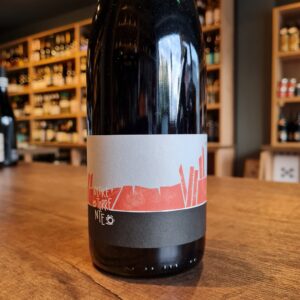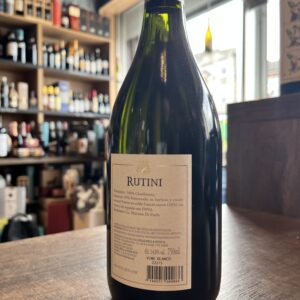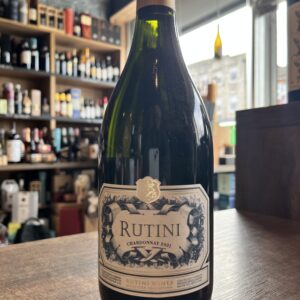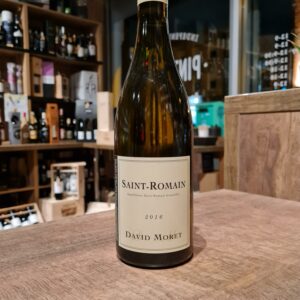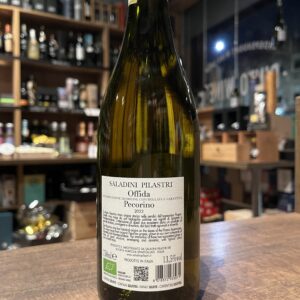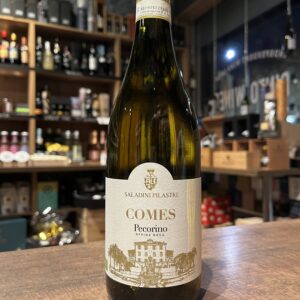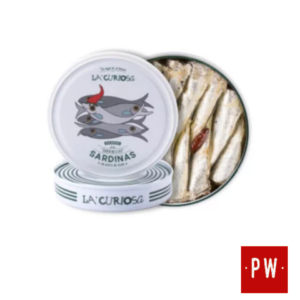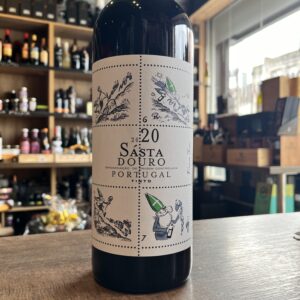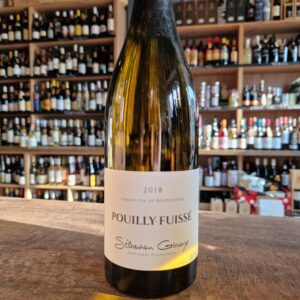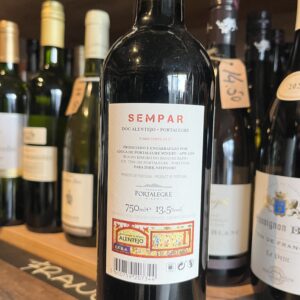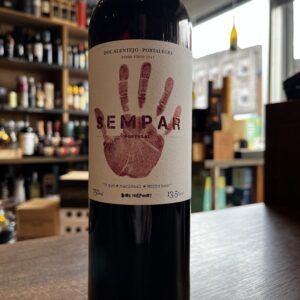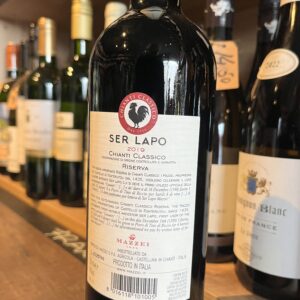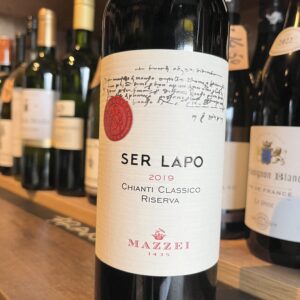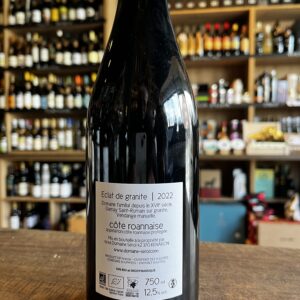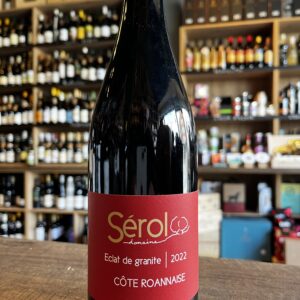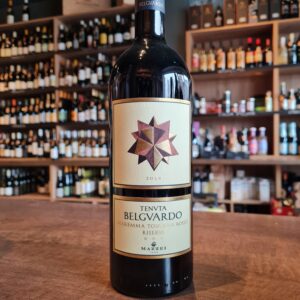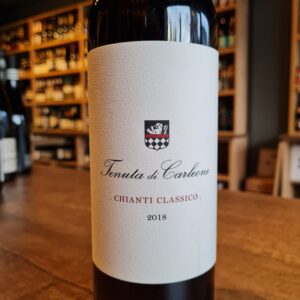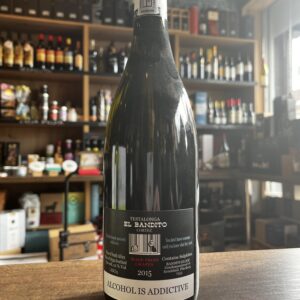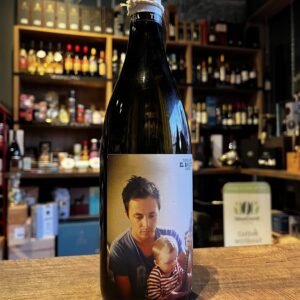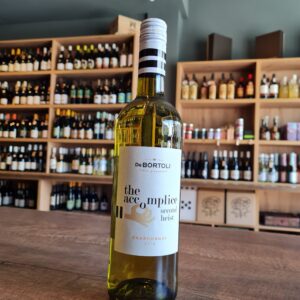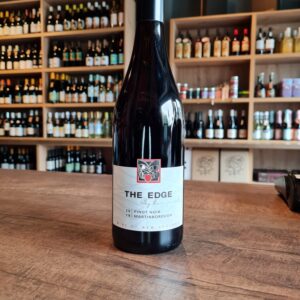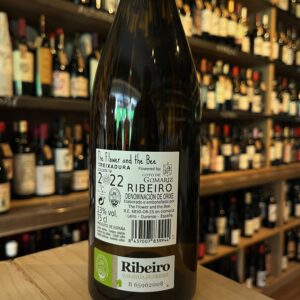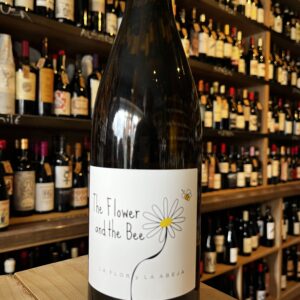-
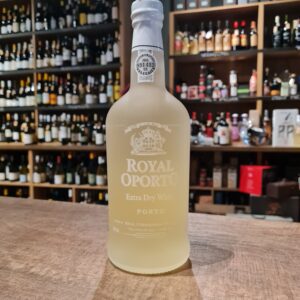 The Port is by difinition, generous and full-bodied wine, produced in the region Douro- the demarcated region of the world's oldest wines. Made from grapes traditionally used in the region, its wine making process is characterized by adding brandy to the wine in full fermentation. This type of port that inspires moments and new forms of consumption, which we recommend be served as Port Tonic. Classic serving would be as a chilled aperitif, but also you could be adventurous and make a ''Caipi Royal'' or just serve it on the rocks with an orange slice.
The Port is by difinition, generous and full-bodied wine, produced in the region Douro- the demarcated region of the world's oldest wines. Made from grapes traditionally used in the region, its wine making process is characterized by adding brandy to the wine in full fermentation. This type of port that inspires moments and new forms of consumption, which we recommend be served as Port Tonic. Classic serving would be as a chilled aperitif, but also you could be adventurous and make a ''Caipi Royal'' or just serve it on the rocks with an orange slice. -
Out of stock
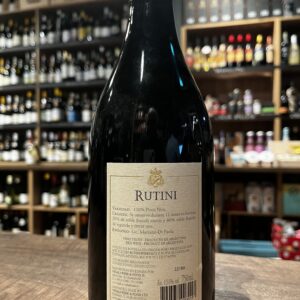
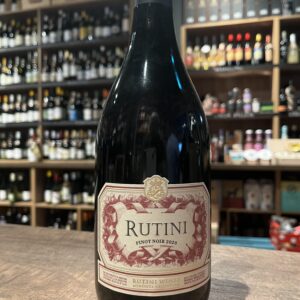 From the start, Felipe Rutini was guided by the motto “Labor and perseverance.” This attitude shaped the development of his wines, which became synonymous with superlative quality. Following his innovative spirit, in 1925 the winery began to plant vines in the Uco Valley. Uco Valley vineyards comprise over 400 hectares at an altitude of between 1,050 and 1,200 meters above sea level. An additional 120 hectares of fields that are currently being planted with vines will expand the winery’s possibilities for producing unique wines that are carefully tended to and nurtured from the very beginning. Very promising wines that need that leap of faith due to price. I suppose Mariano Di Paola being within the best 30 best winemakers in the world may have something to do with it... We do recomend it, just not everyday!
From the start, Felipe Rutini was guided by the motto “Labor and perseverance.” This attitude shaped the development of his wines, which became synonymous with superlative quality. Following his innovative spirit, in 1925 the winery began to plant vines in the Uco Valley. Uco Valley vineyards comprise over 400 hectares at an altitude of between 1,050 and 1,200 meters above sea level. An additional 120 hectares of fields that are currently being planted with vines will expand the winery’s possibilities for producing unique wines that are carefully tended to and nurtured from the very beginning. Very promising wines that need that leap of faith due to price. I suppose Mariano Di Paola being within the best 30 best winemakers in the world may have something to do with it... We do recomend it, just not everyday! -
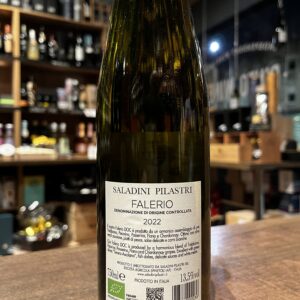
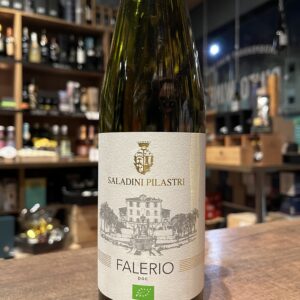 Saladini Pilastri is located in Spinetoli, in the Marche region of Italy . The history of the Counts Saladini Pilastri, a noble family from Ascoli Piceno, dates back to the early 1000s, but it is only for around 300 years that the family has been dedicated to wine production. Its 320 hectare wine estate is located in the heart of the Rosso Piceno production area. From the 1970s, new vines were planted; The current winery was built next to the splendid 15th century country house “Vigna Palazzi”, which originally served as a production site, so that all production could be kept in one place. The vineyard has been certified in organic farming since 1994. The climate here is Mediterranean, with hot, dry summers tempered by the maritime influence of the Adriatic Sea only 8km away from the vineyards. All the farming is organic and the winery is equipped with all the latest wine-making mod cons, helping speeding up the complex time of production and maintain quality. In true Italian style-Great wine with great food it helps that at the heart of the estate is a plush mansion house with a sweet swimming pool!. True quality of life. If I wasn't Portuguese, Italy would be where I would retire. Food-friendly as they come, its easy-going qualities match well with antipasti or even creamy pasta dishes but especially fish orientated dishes. Goditi il Vino!
Saladini Pilastri is located in Spinetoli, in the Marche region of Italy . The history of the Counts Saladini Pilastri, a noble family from Ascoli Piceno, dates back to the early 1000s, but it is only for around 300 years that the family has been dedicated to wine production. Its 320 hectare wine estate is located in the heart of the Rosso Piceno production area. From the 1970s, new vines were planted; The current winery was built next to the splendid 15th century country house “Vigna Palazzi”, which originally served as a production site, so that all production could be kept in one place. The vineyard has been certified in organic farming since 1994. The climate here is Mediterranean, with hot, dry summers tempered by the maritime influence of the Adriatic Sea only 8km away from the vineyards. All the farming is organic and the winery is equipped with all the latest wine-making mod cons, helping speeding up the complex time of production and maintain quality. In true Italian style-Great wine with great food it helps that at the heart of the estate is a plush mansion house with a sweet swimming pool!. True quality of life. If I wasn't Portuguese, Italy would be where I would retire. Food-friendly as they come, its easy-going qualities match well with antipasti or even creamy pasta dishes but especially fish orientated dishes. Goditi il Vino! -
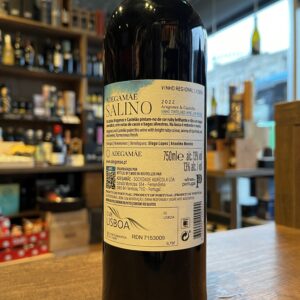
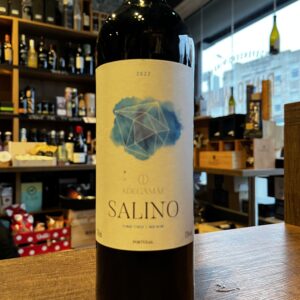 Salino is from north from Lisbon (Torres Vedras) and just a step away from the ocean, AdegaMãe brings out the best of a terroir strongly influenced by the prevailing sea breezes, standing out for its Atlantic-inspired wines, brimming with character, freshness and minerality. The winery was built by the Alves family, founder of Riberalves Group, AdegaMãe is born as a tribute from the men to the family’s matriarch, Manuela Alves. On this particular project, 2 star winemakers were asked to do an everydays wine that brings quality and immediate expression to the palate. Pair it with Charcuterie of all sorts, red meats and stews
Salino is from north from Lisbon (Torres Vedras) and just a step away from the ocean, AdegaMãe brings out the best of a terroir strongly influenced by the prevailing sea breezes, standing out for its Atlantic-inspired wines, brimming with character, freshness and minerality. The winery was built by the Alves family, founder of Riberalves Group, AdegaMãe is born as a tribute from the men to the family’s matriarch, Manuela Alves. On this particular project, 2 star winemakers were asked to do an everydays wine that brings quality and immediate expression to the palate. Pair it with Charcuterie of all sorts, red meats and stews -
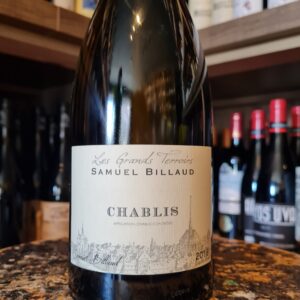 This excellent Chablis has a fine balance of ripe fruit and thrilling acidity. With a great length on the finish, it will develop with age in the cellar if you can keep your hands off it. Sourced from three parcels of vines in different sectors of the appellation; Les Pargues towards the village of Préhy, Les Cartes between the premiers crus of Vaillons and Montmains where the vines are 60 years old and Bas de Chapelots just below Montée de Tonnerre. Samuel Billaud is one of Chablis’ greatest winemakers. For twenty years he was responsible for the superb quality of wine at the family estate, Domaine Billaud-Simon, before setting up his own winery in 2009, where he produces a range of wines from several of the region’s finest sites. In 2014 he recovered his share of the Billaud-Simon vines which he now vinifies and bottles under his own name.
This excellent Chablis has a fine balance of ripe fruit and thrilling acidity. With a great length on the finish, it will develop with age in the cellar if you can keep your hands off it. Sourced from three parcels of vines in different sectors of the appellation; Les Pargues towards the village of Préhy, Les Cartes between the premiers crus of Vaillons and Montmains where the vines are 60 years old and Bas de Chapelots just below Montée de Tonnerre. Samuel Billaud is one of Chablis’ greatest winemakers. For twenty years he was responsible for the superb quality of wine at the family estate, Domaine Billaud-Simon, before setting up his own winery in 2009, where he produces a range of wines from several of the region’s finest sites. In 2014 he recovered his share of the Billaud-Simon vines which he now vinifies and bottles under his own name. -
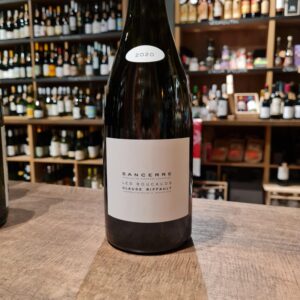 At barely 30 years old, Stephane Riffault (Claude’s son and now owner of the estate) is turning out Sancerre bottlings that are the envy of many producers twice his age. As David Schildknecht put it, “make no mistake: this address in the hamlet of Maison Salle (Sury-en-Vaux) is now one of the five or six most exciting estates in the Sancerre appellation.” Given that Stephane’s holdings represent 4 tenths of 1 percent of the appellation, this kid is clearly doing something right. Based in the village of Sury-en-Vaux, the domaine works 33 different parcels in 6 different lieu-dits spread across 4 villages. The 13.5 hectares of vines are plowed and no synthetic material is used. Unlike most Sancerre producers, the entire harvest is carried out by hand and an extensive sorting takes place before the grapes are crushed. Stephane’s wife, Benedicte, leads the harvest team while Stephane manages the sorting and press during harvest. Most of the domaine’s holdings are planted on the soft limestone soil called Terres Blanches with some parcels on calliottes and silex. Small, judicious uses of oak help to add length to the already precise and vertical bottling. All of the parcels are vilified separately and with the exception of the rose, all the wines are bottled unfiltered. Having studied and worked in Burgundy (and closely with Olivier Leflaive), it’s easy to see the Burgundian influence in Stephane’s wines. The mastery of minerality standing shoulder-height with the wood is rarely duplicated in Sancerre. Regardless of the exposition of his parcels (many are south-facing), Riffault’s wines are always crisp and high-cut with a jeweled sort of delineation that speaks to the precision and attention these wines get. These are not your daddy’s (or his daddy’s) Sancerres.
At barely 30 years old, Stephane Riffault (Claude’s son and now owner of the estate) is turning out Sancerre bottlings that are the envy of many producers twice his age. As David Schildknecht put it, “make no mistake: this address in the hamlet of Maison Salle (Sury-en-Vaux) is now one of the five or six most exciting estates in the Sancerre appellation.” Given that Stephane’s holdings represent 4 tenths of 1 percent of the appellation, this kid is clearly doing something right. Based in the village of Sury-en-Vaux, the domaine works 33 different parcels in 6 different lieu-dits spread across 4 villages. The 13.5 hectares of vines are plowed and no synthetic material is used. Unlike most Sancerre producers, the entire harvest is carried out by hand and an extensive sorting takes place before the grapes are crushed. Stephane’s wife, Benedicte, leads the harvest team while Stephane manages the sorting and press during harvest. Most of the domaine’s holdings are planted on the soft limestone soil called Terres Blanches with some parcels on calliottes and silex. Small, judicious uses of oak help to add length to the already precise and vertical bottling. All of the parcels are vilified separately and with the exception of the rose, all the wines are bottled unfiltered. Having studied and worked in Burgundy (and closely with Olivier Leflaive), it’s easy to see the Burgundian influence in Stephane’s wines. The mastery of minerality standing shoulder-height with the wood is rarely duplicated in Sancerre. Regardless of the exposition of his parcels (many are south-facing), Riffault’s wines are always crisp and high-cut with a jeweled sort of delineation that speaks to the precision and attention these wines get. These are not your daddy’s (or his daddy’s) Sancerres. -
Out of stock
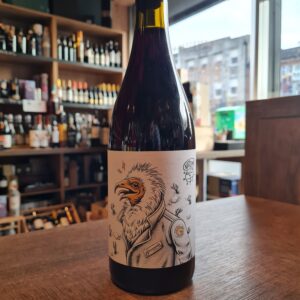 Ricardo Alves and Frederico Machado visited Bemposta for the first time together in 2017. They were on the Portuguese back roads in the Parque Natural das Arribas do Douro, with its wealth of ancient, indigenous and largely forgotten grapevines chaotically perched on the extreme slopes on the Douro river gorge, when they came upon the perfect location for their life project, the place to which they would commit their youth. They set out to rediscover and revitalize an ancient wine culture whose local home winegrowers have just barely kept the faint bloodline of their vinous history from extinction. Trás-os-Montes is a large, but not too well known, wine region of north eastern Portugal (Translation: behind the Mountains), is where the Arribas Wine Company are based and both are very passionate have been making some very interesting wines. Saroto Tinto is made from a small, old parcel of vines comprised of old-fashioned red and white Douro varieties. The resultant wine is full of wild forest fruit, lots of berries with a kick of natural sourness. Plenty of fresh acidity adds juiciness and balances the rustic, grippy tannins, making for quite a light red. Earthy minerality adds extra complexity and the finish is long and moreish. Its bottled unfined and unfiltered so may have natural sediment in the bottle.
Ricardo Alves and Frederico Machado visited Bemposta for the first time together in 2017. They were on the Portuguese back roads in the Parque Natural das Arribas do Douro, with its wealth of ancient, indigenous and largely forgotten grapevines chaotically perched on the extreme slopes on the Douro river gorge, when they came upon the perfect location for their life project, the place to which they would commit their youth. They set out to rediscover and revitalize an ancient wine culture whose local home winegrowers have just barely kept the faint bloodline of their vinous history from extinction. Trás-os-Montes is a large, but not too well known, wine region of north eastern Portugal (Translation: behind the Mountains), is where the Arribas Wine Company are based and both are very passionate have been making some very interesting wines. Saroto Tinto is made from a small, old parcel of vines comprised of old-fashioned red and white Douro varieties. The resultant wine is full of wild forest fruit, lots of berries with a kick of natural sourness. Plenty of fresh acidity adds juiciness and balances the rustic, grippy tannins, making for quite a light red. Earthy minerality adds extra complexity and the finish is long and moreish. Its bottled unfined and unfiltered so may have natural sediment in the bottle. -
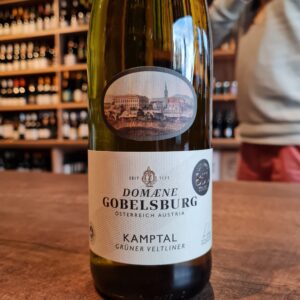 Like every vintage, the Grüner Veltliner Domain Gobelsburg is the benchmark wine in this price range, balanced, juicy and delicate, that's how Veltliner is fun. Delicate spice on the nose with some Boskop apple, Williams pear and herbaceous hints of thyme and mint. On the palate a rather soft texture, gentle fruit with a nice acidic accompaniment, delicately piquant pepper, then some minerality comes through. Again one of the most harmonious entry-level Veltliners of this vintage!
Like every vintage, the Grüner Veltliner Domain Gobelsburg is the benchmark wine in this price range, balanced, juicy and delicate, that's how Veltliner is fun. Delicate spice on the nose with some Boskop apple, Williams pear and herbaceous hints of thyme and mint. On the palate a rather soft texture, gentle fruit with a nice acidic accompaniment, delicately piquant pepper, then some minerality comes through. Again one of the most harmonious entry-level Veltliners of this vintage! -
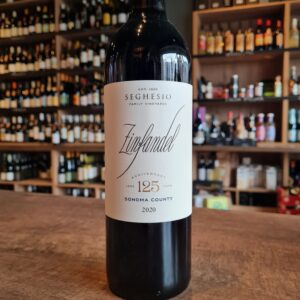 The Seghesio family began making wine in California in 1895 when Edoardo Seghesio planted Zinfandel vines in Alexander Valley. Over the intervening years the third generation of the family, Pete Seghesio and his cousin Ted Seghesio, established the estate as a top producer of Californian Zinfandel. Today the winery has 120 hectares of vineyards which are all farmed sustainably in the appellations of Dry Creek Valley, Alexander Valley and Russian River Valley. The vines for this bottling come from estate vineyards in Dry Creek and Alexander Valley with careful management of yields to ensure excellent quality. The robust flavour profile makes this a great partner for barbecued meats and steak, although it can also be kept in the cellar for another few years.
The Seghesio family began making wine in California in 1895 when Edoardo Seghesio planted Zinfandel vines in Alexander Valley. Over the intervening years the third generation of the family, Pete Seghesio and his cousin Ted Seghesio, established the estate as a top producer of Californian Zinfandel. Today the winery has 120 hectares of vineyards which are all farmed sustainably in the appellations of Dry Creek Valley, Alexander Valley and Russian River Valley. The vines for this bottling come from estate vineyards in Dry Creek and Alexander Valley with careful management of yields to ensure excellent quality. The robust flavour profile makes this a great partner for barbecued meats and steak, although it can also be kept in the cellar for another few years. -
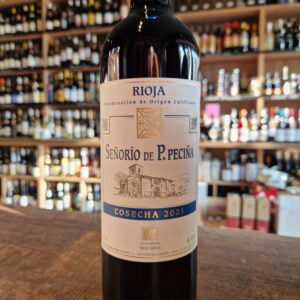 Bodegas Hermanos de Peciña is firmly planted in the old school camp. Although the estate was started only in 1992, its founder, Pedro Peciña had worked for over 20 years prior to that as the head agronomist for La Rioja Alta, learning all facets of production and especially the planting and managing of all the estate’s vineyards. The Peciña winery and vineyards are located in San Vicente, which while technically in the Rioja Alta sub-zone, is not in the vicinity of Haro where most of the other traditional Rioja houses have their cellars. Rather it is located on the northeast side of the Ebro river near the border of the Basque Alavesa zone. These vineyards - many 40 to 60 years old - are actually some of the finest in the appellation as they fall at the foothills of the Sierra Cantabria Mountains at an average of 500 meters, and offer hillside expositions as well as complex and diverse soils. Many of Peciña’s most prized vineyards are actually on north facing slopes which Pedro feels helps give the wines good freshness and delineation. Serve with aperitif, Charcuterie, Cured cheeses, Smoked foods
Bodegas Hermanos de Peciña is firmly planted in the old school camp. Although the estate was started only in 1992, its founder, Pedro Peciña had worked for over 20 years prior to that as the head agronomist for La Rioja Alta, learning all facets of production and especially the planting and managing of all the estate’s vineyards. The Peciña winery and vineyards are located in San Vicente, which while technically in the Rioja Alta sub-zone, is not in the vicinity of Haro where most of the other traditional Rioja houses have their cellars. Rather it is located on the northeast side of the Ebro river near the border of the Basque Alavesa zone. These vineyards - many 40 to 60 years old - are actually some of the finest in the appellation as they fall at the foothills of the Sierra Cantabria Mountains at an average of 500 meters, and offer hillside expositions as well as complex and diverse soils. Many of Peciña’s most prized vineyards are actually on north facing slopes which Pedro feels helps give the wines good freshness and delineation. Serve with aperitif, Charcuterie, Cured cheeses, Smoked foods -
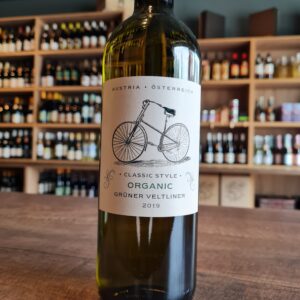 All Sepp Moser wines have been organic (and all estate wines biodynamic) since 2007. The Sepp Moser Estate comprises of 50 acres of vineyards in two prominent wine regions; Kremstal and Neusiedlersee. Now run by Sepp's son Nikolaus, he produces an international range of varieties as well as the ever more important local varieties of Gruner Veltliner and Riesling in the Kremstal. Delicate aromas of pear, kiwi, apricot and white spice. On the palate stone fruit flavours and white pepper lead to a gently textured, mineral and citrus finish. Great with fish, Chicken or light dishes in general. Lovely on its own on hot summer day
All Sepp Moser wines have been organic (and all estate wines biodynamic) since 2007. The Sepp Moser Estate comprises of 50 acres of vineyards in two prominent wine regions; Kremstal and Neusiedlersee. Now run by Sepp's son Nikolaus, he produces an international range of varieties as well as the ever more important local varieties of Gruner Veltliner and Riesling in the Kremstal. Delicate aromas of pear, kiwi, apricot and white spice. On the palate stone fruit flavours and white pepper lead to a gently textured, mineral and citrus finish. Great with fish, Chicken or light dishes in general. Lovely on its own on hot summer day -
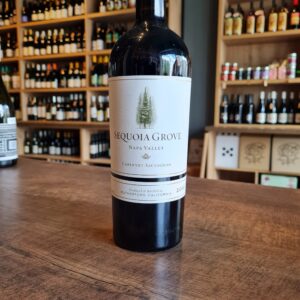 Family-owned winery Sequoia Grove was founded in 1979 in a 110-year old barn beneath a grove of Sequoia trees in Rutherford. Michael Trujillo joined the winery as assistant winemaker in 1981, becoming director of winemaking in 2002. His philosophy is based on balance in the vineyard, planting different blocks with different clones, and farming without pesticides. The family have been working with their partner growers for decades which gives them access to the very best quality fruit each year and allows them to create this complex wine which truly expresses the Rutherford terroir. The young wine is aged in oak barrel for 20 months which adds sweet spice notes and extra complexity to the finished bottling. The rich, powerful flavor profile makes this a winner with lovers of big, bold reds and a great match for red meats. Drink now through to 2030. Decanting is always recommended but is not a must
Family-owned winery Sequoia Grove was founded in 1979 in a 110-year old barn beneath a grove of Sequoia trees in Rutherford. Michael Trujillo joined the winery as assistant winemaker in 1981, becoming director of winemaking in 2002. His philosophy is based on balance in the vineyard, planting different blocks with different clones, and farming without pesticides. The family have been working with their partner growers for decades which gives them access to the very best quality fruit each year and allows them to create this complex wine which truly expresses the Rutherford terroir. The young wine is aged in oak barrel for 20 months which adds sweet spice notes and extra complexity to the finished bottling. The rich, powerful flavor profile makes this a winner with lovers of big, bold reds and a great match for red meats. Drink now through to 2030. Decanting is always recommended but is not a must -
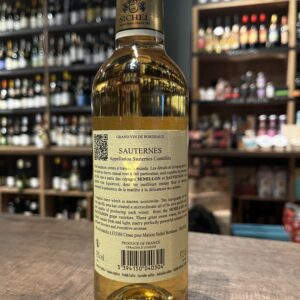
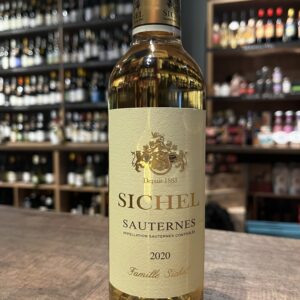 This is a declassified wine from a top Chateau in Sauternes...shhh, they dont want you to know their name! or...just keep reading Maison Sichel is a Bordeaux based, family owned and run negociant of six generations. The Sichel family have been a sugnificant prescence in Bordeaux since 1883 and have continued to expand operations by purchasing several properties in Bordeaux including Chateau Angludet and Chateau Argaden. The Sichel family also joined with three other family in 1938 to purchase the now legendary Chateau Palmer. Maison Sichel continued to expand their operations outside of Bordeaux with Chateau Trillol in Corbieres and have several high quality own label wines such as the Sichel Sauternes and the Sichel Margaux. The Sichekl Vineyards are situated some 40 kilometers south east of Bordeaux, between the Garonne river and the Landes forest to the south. A blend of 80% Semillon, 15% Sauvignon Blanc and 5% Muscadelle from 50 year old vines where Botrytis is encouraged to dehydrate the grapes. This Sauterne has been aged for 10 to 12 months.
This is a declassified wine from a top Chateau in Sauternes...shhh, they dont want you to know their name! or...just keep reading Maison Sichel is a Bordeaux based, family owned and run negociant of six generations. The Sichel family have been a sugnificant prescence in Bordeaux since 1883 and have continued to expand operations by purchasing several properties in Bordeaux including Chateau Angludet and Chateau Argaden. The Sichel family also joined with three other family in 1938 to purchase the now legendary Chateau Palmer. Maison Sichel continued to expand their operations outside of Bordeaux with Chateau Trillol in Corbieres and have several high quality own label wines such as the Sichel Sauternes and the Sichel Margaux. The Sichekl Vineyards are situated some 40 kilometers south east of Bordeaux, between the Garonne river and the Landes forest to the south. A blend of 80% Semillon, 15% Sauvignon Blanc and 5% Muscadelle from 50 year old vines where Botrytis is encouraged to dehydrate the grapes. This Sauterne has been aged for 10 to 12 months. -
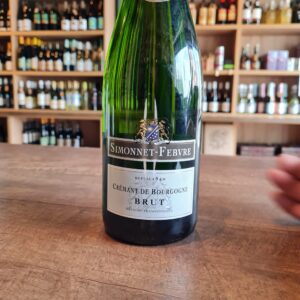 Simmonet-Febvre has been producing its wines with traditional methods since 1840. It is the only Maison in Chablis to produce Crémants of Burgundy. A harmoniously balanced wine with fine bubbles, a persistent foam and a wonderful length in the mouth. It is fresh and powerful on the nose with aromas of citrus. Drink this crémant as a chilled aperitif, as it comes or with a liqueur such as crème de cassis, and why not even drink it throughout a whole meal.
Simmonet-Febvre has been producing its wines with traditional methods since 1840. It is the only Maison in Chablis to produce Crémants of Burgundy. A harmoniously balanced wine with fine bubbles, a persistent foam and a wonderful length in the mouth. It is fresh and powerful on the nose with aromas of citrus. Drink this crémant as a chilled aperitif, as it comes or with a liqueur such as crème de cassis, and why not even drink it throughout a whole meal. -
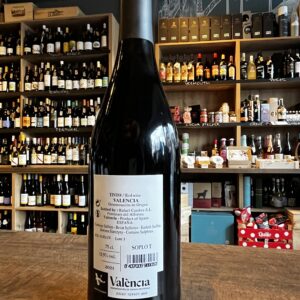
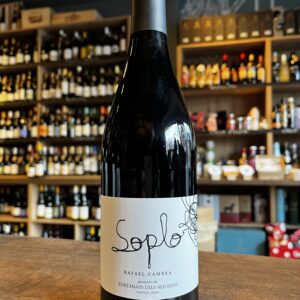 Rafael Cambra has spent most of his life in a vineyard. His family own one of the most prestigious nurseries in Spain, with clients like Vega Sicilia, Alvaro Palacios and many more. He established his own cellar in 2001 after finding a vineyard with 50-year-old Monastrell vines. He also planted some Cabernet Sauvignon and Cabernet Franc. The vineyards lie in the lowest part of the Sierra, inland from Valencia, with olive and almond trees surrounding them. Rafael believes in minimal intervention when it comes to wine-making, creating elegant yet restrained wines. He is an innovative wine-maker, constantly experimenting with different grapes and blends until completely satisfied with the result. Charcuterie, Red meat, White meat, Poultry, Mushroom, Barbecue, Exotic cuisine, Cheese.
Rafael Cambra has spent most of his life in a vineyard. His family own one of the most prestigious nurseries in Spain, with clients like Vega Sicilia, Alvaro Palacios and many more. He established his own cellar in 2001 after finding a vineyard with 50-year-old Monastrell vines. He also planted some Cabernet Sauvignon and Cabernet Franc. The vineyards lie in the lowest part of the Sierra, inland from Valencia, with olive and almond trees surrounding them. Rafael believes in minimal intervention when it comes to wine-making, creating elegant yet restrained wines. He is an innovative wine-maker, constantly experimenting with different grapes and blends until completely satisfied with the result. Charcuterie, Red meat, White meat, Poultry, Mushroom, Barbecue, Exotic cuisine, Cheese. -
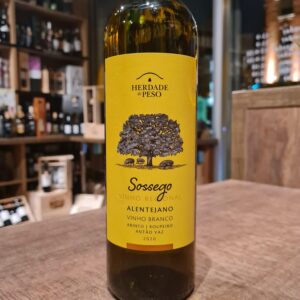 Sogrape Vinhos has been investing in the classic winegrowing regions of Portugal since it was set up in 1942. With a strong presence in the regions of Dão, Douro and (MInho) Vinhos Verdes, their entrance into the Alentejo — the winegrowing region with the highest growth rate in the country — was a natural step. Herdade do Peso Sossego Branco offers the authenticity and immediate passion of Alentejo flavors in a refreshing and aromatic wine. Herdade do Peso is the brand that revitalizes the deepest essence of the region, brought to the surface by the science and know-how of Sogrape Vinhos. The result is the production of exuberant and attractive wines, whose flavors, aromas and colors remind us of life at its best, just like the region where they are born. Sossego White is a refreshing wine that is full of flavour, perfect when served on its own or as na aperitif. It is an excellent accompaniment to various fish dishes, white meats and a variety of salads.
Sogrape Vinhos has been investing in the classic winegrowing regions of Portugal since it was set up in 1942. With a strong presence in the regions of Dão, Douro and (MInho) Vinhos Verdes, their entrance into the Alentejo — the winegrowing region with the highest growth rate in the country — was a natural step. Herdade do Peso Sossego Branco offers the authenticity and immediate passion of Alentejo flavors in a refreshing and aromatic wine. Herdade do Peso is the brand that revitalizes the deepest essence of the region, brought to the surface by the science and know-how of Sogrape Vinhos. The result is the production of exuberant and attractive wines, whose flavors, aromas and colors remind us of life at its best, just like the region where they are born. Sossego White is a refreshing wine that is full of flavour, perfect when served on its own or as na aperitif. It is an excellent accompaniment to various fish dishes, white meats and a variety of salads. -
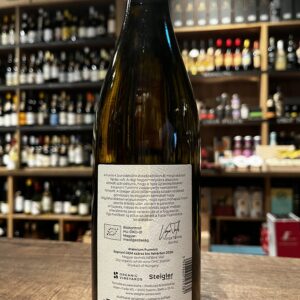
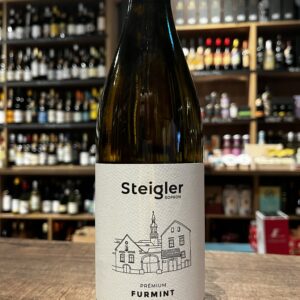 Furmint is Hungary's most prestigious white variety, capable of an ageing potential that of the best Rieslings. In it's youth Furmint is neutral, mineral, high on acidity. With age it picks up tertiary spices, asian herbs and ginger notes. Food friendly and complex, a wine expert's dream. We find Furmints at their optimum balance after at least 4 years, from then on it is only upwards. Mica schist soil adds a reductive savoury element to the wine that spent 10 months on the lees in 500l Hungarian Quercus Petraea barrels.
Furmint is Hungary's most prestigious white variety, capable of an ageing potential that of the best Rieslings. In it's youth Furmint is neutral, mineral, high on acidity. With age it picks up tertiary spices, asian herbs and ginger notes. Food friendly and complex, a wine expert's dream. We find Furmints at their optimum balance after at least 4 years, from then on it is only upwards. Mica schist soil adds a reductive savoury element to the wine that spent 10 months on the lees in 500l Hungarian Quercus Petraea barrels. -
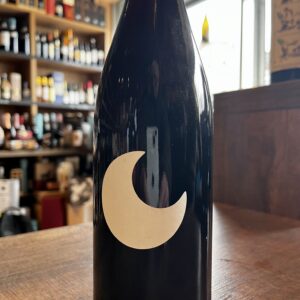
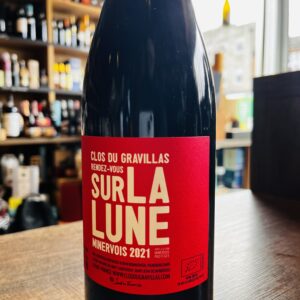 This Sur La Lune from Le Clos du Gravillas is a dazzling expanse of white limestone pebbles on a plateau at an altitude of 300 meters in the Haut Languedoc Natural Park. Between the gorges of St Chinian and Minerve, surrounded by scrubland and holm oaks, the 8.30 hectare estate is managed with respect for the terroir, in organic farming with concern for the preservation of the biodiversity of fauna and the surrounding flora. This wine comes from 3 plots on the Cazelles plateau: Syrah from a place called “Esperandieu”, a very pretty place surrounded by hills covered with scrubland, almond trees, broom and oaks where they also planted 48 pomegranate trees, 25 fig trees as well as cherry and apricot trees. The 80 year old vine of Carignan planted with Grenache from the place called Carretals and the 40-year-old Carignan vine from the place called Roque de Beau. Serve rather chilled but not too cold, ensuring that the wine does not heat up excessively in the bottle or in the glasses. A slight opening time prior to service may be beneficial.vThis wine beyond all the technicallities and sense of place it is a straight wine without organoleptic deviation, without volatile phenols, pure, with perfect control and ultimately delicious. Slainte!
This Sur La Lune from Le Clos du Gravillas is a dazzling expanse of white limestone pebbles on a plateau at an altitude of 300 meters in the Haut Languedoc Natural Park. Between the gorges of St Chinian and Minerve, surrounded by scrubland and holm oaks, the 8.30 hectare estate is managed with respect for the terroir, in organic farming with concern for the preservation of the biodiversity of fauna and the surrounding flora. This wine comes from 3 plots on the Cazelles plateau: Syrah from a place called “Esperandieu”, a very pretty place surrounded by hills covered with scrubland, almond trees, broom and oaks where they also planted 48 pomegranate trees, 25 fig trees as well as cherry and apricot trees. The 80 year old vine of Carignan planted with Grenache from the place called Carretals and the 40-year-old Carignan vine from the place called Roque de Beau. Serve rather chilled but not too cold, ensuring that the wine does not heat up excessively in the bottle or in the glasses. A slight opening time prior to service may be beneficial.vThis wine beyond all the technicallities and sense of place it is a straight wine without organoleptic deviation, without volatile phenols, pure, with perfect control and ultimately delicious. Slainte! -
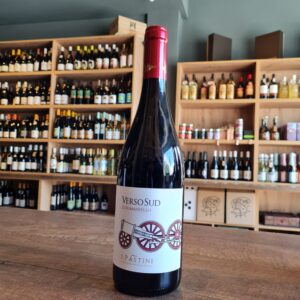 Imported from nearby Dalmatia, Susumaniello is one of the most important indigenous grape varieties of Brindisi. Its name (there are several theories) is due to the fact that, at a young age, in not recent times, the Susumaniello plant was particularly productive, so much so that it was overloaded with bunches as if it were a donkey. The name Verso Sud indicates the position of the vineyards, located in the southernmost area of the Ítria Valley, arriving in the province of Brindisi. Verso Sud Susumaniello has an intense ruby red color, with violet reflections when young that tend to garnet with aging, with a persistent aroma with hints of blackberry and cherry and sweet toasted notes. The flavor is soft, harmonious, long finish. Red 'Clássico', ideal to accompany red meats, roasts, game. Excellent with aged cheeses, cured meats, sauces and parmesan. A very decent and great value alternative to the more northerly Amarone style of wine.
Imported from nearby Dalmatia, Susumaniello is one of the most important indigenous grape varieties of Brindisi. Its name (there are several theories) is due to the fact that, at a young age, in not recent times, the Susumaniello plant was particularly productive, so much so that it was overloaded with bunches as if it were a donkey. The name Verso Sud indicates the position of the vineyards, located in the southernmost area of the Ítria Valley, arriving in the province of Brindisi. Verso Sud Susumaniello has an intense ruby red color, with violet reflections when young that tend to garnet with aging, with a persistent aroma with hints of blackberry and cherry and sweet toasted notes. The flavor is soft, harmonious, long finish. Red 'Clássico', ideal to accompany red meats, roasts, game. Excellent with aged cheeses, cured meats, sauces and parmesan. A very decent and great value alternative to the more northerly Amarone style of wine. -
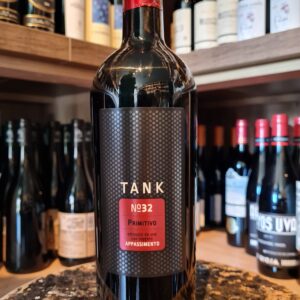 The TANK No 32 Primitivo Appassimento from Cantine Minini sparkles a wonderful dark red wine. This Italian red inspires with its perfect combination of elegance and power. The bouquet reveals aromas of ripe cherries, juicy plums and dried fruit, especially figs, dates and raisins come to mind. The palate of TANK 32 impresses with its dense and concentrated character. The pleasant and equally discreet residual sweetness gives this red wine a wonderful velvety texture. The long finish of Tank No 32 is carried by delicate notes of nougat and dark chocolate. The Tank No 32 Apassimento is a great accompaniment to strong game dishes with fresh mushrooms and well matured cheeses.
The TANK No 32 Primitivo Appassimento from Cantine Minini sparkles a wonderful dark red wine. This Italian red inspires with its perfect combination of elegance and power. The bouquet reveals aromas of ripe cherries, juicy plums and dried fruit, especially figs, dates and raisins come to mind. The palate of TANK 32 impresses with its dense and concentrated character. The pleasant and equally discreet residual sweetness gives this red wine a wonderful velvety texture. The long finish of Tank No 32 is carried by delicate notes of nougat and dark chocolate. The Tank No 32 Apassimento is a great accompaniment to strong game dishes with fresh mushrooms and well matured cheeses. -
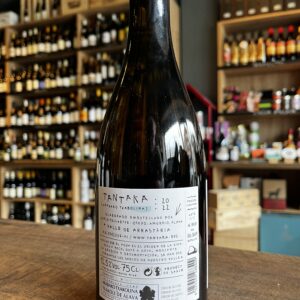
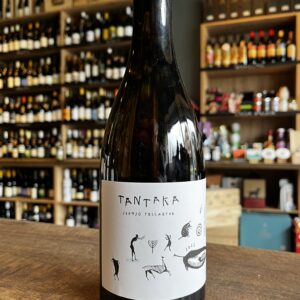 Tantaka is a white wine aged on lees made with the Hondarribi Zuri variety in the D.O. Arabako-txakolina (Basque Country) by Juanjo Tellaetxe. Juanjo Tellaetxe which happens to be a priest and a shepherd made his dream a reality when he implemented his work philosophy in the Arrastaria Valley vineyards (Álava) to make honest wines with a strong local character. To do that, the Tantaka winery is committed to using native varieties, cultivated in an environmentally-respectful way and with minimum intervention in the winery. The soils are characterised by their alluvial and semi-deep character, with a climate that ranges from Atlantic to continental, depending on the vintage Pair it with seafood, baked fish, vegetables and pork.
Tantaka is a white wine aged on lees made with the Hondarribi Zuri variety in the D.O. Arabako-txakolina (Basque Country) by Juanjo Tellaetxe. Juanjo Tellaetxe which happens to be a priest and a shepherd made his dream a reality when he implemented his work philosophy in the Arrastaria Valley vineyards (Álava) to make honest wines with a strong local character. To do that, the Tantaka winery is committed to using native varieties, cultivated in an environmentally-respectful way and with minimum intervention in the winery. The soils are characterised by their alluvial and semi-deep character, with a climate that ranges from Atlantic to continental, depending on the vintage Pair it with seafood, baked fish, vegetables and pork. -
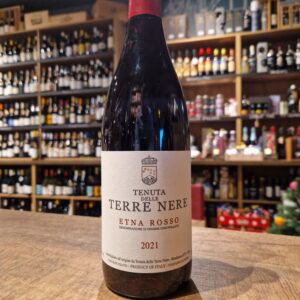
On the island of Sicily, at the foot of Mount Etna, brothers Marco and Sebastian De Grazia have been running their winemaking project for more than 30 years. At Tenuta Delle Terre Nere they make refined and pure wines that express the extraordinary location they call home. Starting with excellent raw materials and winemaking with very little intervention, the De Grazia brothers’ work has helped put Etna at the top of the world wine map.
Tenuta Delle Terre Nere Etna Rosso comes from both young and old vines that grow on the north slope of Mount Etna. These vines are planted in volcanic soil at an altitude ranging from 600 to 900 metres above sea level. Organic farming is practiced and the yield is limited to 35 hl. per hectare. The harvest is carried out manually at the optimum point of ripeness.
Pure and elegant, Tenuta Delle Terre Nere Etna Rosso is a red wine with the delicacy of a Burgundy and the length of a Pinot Noir. A true representative of a promising wine region.
Pair it with white meats, Pasta, Red meat, Rice dishes
-
Out of stock
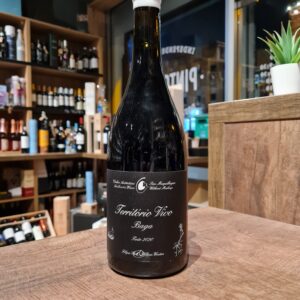 This ''Território Vivo'' is a delicate Baga, it reflects the true term ''living Terroir''. The heritage of old vineyards of the emblematic Baga grape is a richness to be relished. Some of the vines are 80 years old. The subsoils are chalky clay and the vineyards are South East oriented on fairly steep slopes. This particular vintage has fantastic story that could've gone South and thus an unforgettable harvest. They had an attack of rabbits on all of their old vines of Baga. They ate all of the grapes up to 30cm high of the ground. Inedvertently this produced high quality juice but left Filipa and William with the tiniest crops. Producing wine close to nature without pesticides and herbicides can be quite a challenge, certanly when the territory is quite alive!! Serve it with elegant glasses at the temperature of 16-18c and it is highly recommended to pair it with refined foods( not too spicy), Fillet of beef, veal, pigeon, duck and creamy cheeses.
This ''Território Vivo'' is a delicate Baga, it reflects the true term ''living Terroir''. The heritage of old vineyards of the emblematic Baga grape is a richness to be relished. Some of the vines are 80 years old. The subsoils are chalky clay and the vineyards are South East oriented on fairly steep slopes. This particular vintage has fantastic story that could've gone South and thus an unforgettable harvest. They had an attack of rabbits on all of their old vines of Baga. They ate all of the grapes up to 30cm high of the ground. Inedvertently this produced high quality juice but left Filipa and William with the tiniest crops. Producing wine close to nature without pesticides and herbicides can be quite a challenge, certanly when the territory is quite alive!! Serve it with elegant glasses at the temperature of 16-18c and it is highly recommended to pair it with refined foods( not too spicy), Fillet of beef, veal, pigeon, duck and creamy cheeses. -
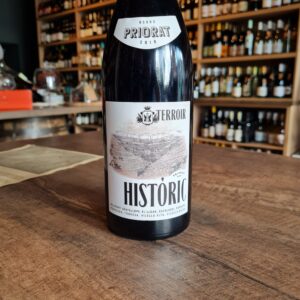 Històric Negre is a red wine from the D.O. Priorat, produced by the Terroir al Límit winery.
Històric Negre is a red wine from the D.O. Priorat, produced by the Terroir al Límit winery.All the wines at Terroir Al Límit are elaborated practicing sustainable viticulture, with a great respect for the nature and its surroundings. The wines are organically farmed following ecological principles. Respect of the environment makes itself throughout the winemaking process, from the grape harvest down to the bottling. The grapes are hand harvested and hand sorted both in the vineyards an the Cellar. Since its beginning in 2004, Terroir Al Limit has reached a highly respected status not only in the region but also worldwide, producing wines of highest purity and maximum expression of terroir.
Made from mostly Garnacha with the remaining quarter being Cariñena the fruit is sourced from vineyards in nine of the historic Priorat villages. The fruit is put in cement tanks, gently crushed and then essentially left to ferment with as little interference as possible. Super elegant wine, with a lot of character and honest expression of the one most iconic regions in Spain.
Decant it for 2 hours, enjoy it with great food or on its own -
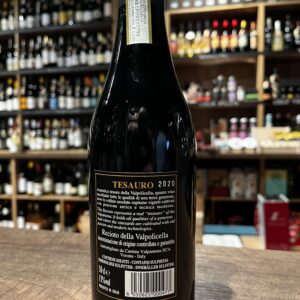
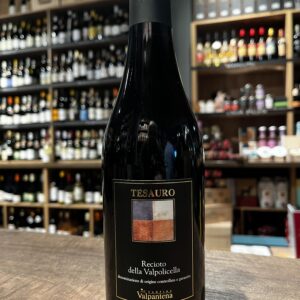 The Torre del Falasco wines are the standard bearers of this co-operative, situated in the Valpantena, northeast of Verona. Known as the ’valley of god’ to the ancient Greeks, this area is well-known for its high quality red wines, due partly to the soils but also because of the cool breeze that blows down the valley from the foothills of the Dolomites. Cantina Valpantena Tesauro Recioto della Valpolicella is the perfect dessert wine and pairs well with chocolate, cheese, and other sweet treats. With its unique blend of grapes and traditional winemaking techniques, this wine is sure to impress even the most discerning of wine lovers.
The Torre del Falasco wines are the standard bearers of this co-operative, situated in the Valpantena, northeast of Verona. Known as the ’valley of god’ to the ancient Greeks, this area is well-known for its high quality red wines, due partly to the soils but also because of the cool breeze that blows down the valley from the foothills of the Dolomites. Cantina Valpantena Tesauro Recioto della Valpolicella is the perfect dessert wine and pairs well with chocolate, cheese, and other sweet treats. With its unique blend of grapes and traditional winemaking techniques, this wine is sure to impress even the most discerning of wine lovers. -
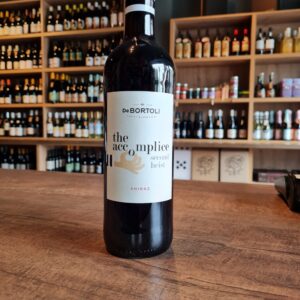 The Shiraz grapes used to craft this youthful wine were harvested in early January, which proved to be a slightly dry season. This elegant De Bortoli The Accomplice Shiraz features a dark crimson colour with ruby highlights throughout the wine. The attractive nose offers fragrances of cherry and raspberry with subtle hints of spice and musk lurking in the background. The sweet and intense palate packs juicy flavours of berry fruit combined with vanilla and nutty oak, and balanced by subtle spicy notes. This medium bodied Shiraz can be cellared for a brief term of 24 months to discover its full flavour potential. It tastes marvellous with pasta, braised pork belly and beef fajitas with salsa.Easy to drink. Enjoy!
The Shiraz grapes used to craft this youthful wine were harvested in early January, which proved to be a slightly dry season. This elegant De Bortoli The Accomplice Shiraz features a dark crimson colour with ruby highlights throughout the wine. The attractive nose offers fragrances of cherry and raspberry with subtle hints of spice and musk lurking in the background. The sweet and intense palate packs juicy flavours of berry fruit combined with vanilla and nutty oak, and balanced by subtle spicy notes. This medium bodied Shiraz can be cellared for a brief term of 24 months to discover its full flavour potential. It tastes marvellous with pasta, braised pork belly and beef fajitas with salsa.Easy to drink. Enjoy! -
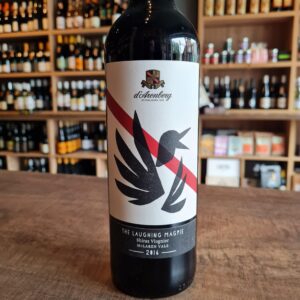 The Kookaburra is a native Australian bird famous for its distinctive laughing call, Chester's young daughters named them 'Laughing Magpies'. The Magpie plumage is black with a stripe of white feathers, representing McLaren Vale's first ever blend combining the (black) Shiraz and its white partner, Viognier. An enticing mix of primary fruit characters entwined with flowers, ginger and stone fruit. A rather dark appearance with a vivid purple hue suggesting a complex dry red. The nose is particularly intense, with peppery spice, hints of fragrant flower and perfume aromas, plus nectarines, apricots, ginger and herbs from the small parcel of viognier that the Shiraz is co-fermented with. On the palate the Shiraz is more dominant. There is some sweeter fruit characters like blackberry, blueberry and boysenberry. The palate is rich and generous and soft silky tannins. Would open 2 hours before serving and use a Decanter when possible. Enjoy this dry red wine from Australia with fillet of beef, dark meat dishes like goulash or the Asian classic Peking duck.
The Kookaburra is a native Australian bird famous for its distinctive laughing call, Chester's young daughters named them 'Laughing Magpies'. The Magpie plumage is black with a stripe of white feathers, representing McLaren Vale's first ever blend combining the (black) Shiraz and its white partner, Viognier. An enticing mix of primary fruit characters entwined with flowers, ginger and stone fruit. A rather dark appearance with a vivid purple hue suggesting a complex dry red. The nose is particularly intense, with peppery spice, hints of fragrant flower and perfume aromas, plus nectarines, apricots, ginger and herbs from the small parcel of viognier that the Shiraz is co-fermented with. On the palate the Shiraz is more dominant. There is some sweeter fruit characters like blackberry, blueberry and boysenberry. The palate is rich and generous and soft silky tannins. Would open 2 hours before serving and use a Decanter when possible. Enjoy this dry red wine from Australia with fillet of beef, dark meat dishes like goulash or the Asian classic Peking duck. -
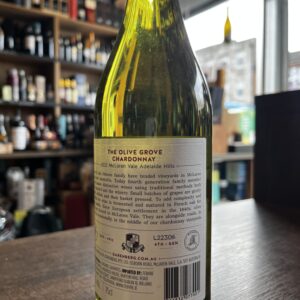
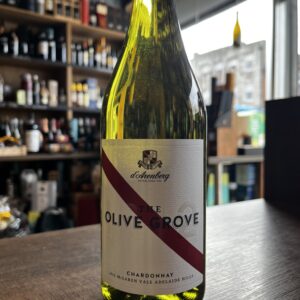 Since 1912 the Osborn family have tended vineyardsin Mclaren Vale, South of Australia. Today fourth generation family member Chester(absolutely bonkers of a guy, draws a room in and within 2 minutes has your attention), makes distintive wines using traditional methods both in the vineyards and the winery. The name comes from European settlements that arised in the 1840’s, and with them olive trees have thrived in McLaren Vale. They are alongside roads, in gardens and occasionally, block their harvesters from doing a fully mechanical job! Perfect with Antipasti, asparagus, chicken and fish
Since 1912 the Osborn family have tended vineyardsin Mclaren Vale, South of Australia. Today fourth generation family member Chester(absolutely bonkers of a guy, draws a room in and within 2 minutes has your attention), makes distintive wines using traditional methods both in the vineyards and the winery. The name comes from European settlements that arised in the 1840’s, and with them olive trees have thrived in McLaren Vale. They are alongside roads, in gardens and occasionally, block their harvesters from doing a fully mechanical job! Perfect with Antipasti, asparagus, chicken and fish -
Out of stock
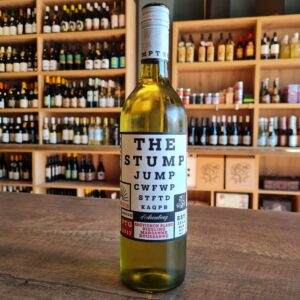 The name ‘Stump Jump’ doesn’t relate to the English game of cricket (jumping over the stumps at the end of the game), nor the breeding of livestock held in the stumps but relates to the significant South Australian invention – the Stump Jump plough. The plough soon became a worldwide implement for ploughing fields because of its ability to ride over stumps and gnarled “mallee” Eucalypt roots and snags, saving valuable time and energy by not stopping the draught horse. Every Stump Jump white of late seems to take the drinker on an interesting journey and this one is no exception. A wonderful fresh vibrant appearance with an equally appealing aroma. Notes of florals, cut grass and limes are obvious but as the wine opens up, more complex secondary notes appear such as green melon rind, passionfruit, lavender, wheat germ, and almond kernel characters. The palate is dry with a moderate level of intensity and ripe fruit characters dominated with Riesling florals and limes; the grassy sweetness and elevated acidity of the Sauvignon Blanc while the Roussanne and Marsanne add an earthy, dry stone fruit element, green almond kernels and a lovely viscous character giving textural richness to the finish. The wine has excellent balance and length of flavour which we see as being an essential element in a great value drink. The Stump Jump is at its best drinking while young, and will continue to develop in the bottle over the next three to five years. It is perfect drinking on a warm summer’s day, and a perfect match for a wide variety of light dishes.
The name ‘Stump Jump’ doesn’t relate to the English game of cricket (jumping over the stumps at the end of the game), nor the breeding of livestock held in the stumps but relates to the significant South Australian invention – the Stump Jump plough. The plough soon became a worldwide implement for ploughing fields because of its ability to ride over stumps and gnarled “mallee” Eucalypt roots and snags, saving valuable time and energy by not stopping the draught horse. Every Stump Jump white of late seems to take the drinker on an interesting journey and this one is no exception. A wonderful fresh vibrant appearance with an equally appealing aroma. Notes of florals, cut grass and limes are obvious but as the wine opens up, more complex secondary notes appear such as green melon rind, passionfruit, lavender, wheat germ, and almond kernel characters. The palate is dry with a moderate level of intensity and ripe fruit characters dominated with Riesling florals and limes; the grassy sweetness and elevated acidity of the Sauvignon Blanc while the Roussanne and Marsanne add an earthy, dry stone fruit element, green almond kernels and a lovely viscous character giving textural richness to the finish. The wine has excellent balance and length of flavour which we see as being an essential element in a great value drink. The Stump Jump is at its best drinking while young, and will continue to develop in the bottle over the next three to five years. It is perfect drinking on a warm summer’s day, and a perfect match for a wide variety of light dishes. -
Out of stock
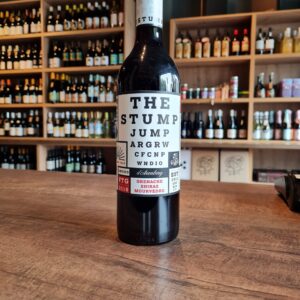 All three varieties play an important role - the Shiraz offers dark plum fruits, mulberries and licorice with plenty of concentration, depth and velvety tannin. The Grenache adds a lovely lusciousness to the wine with raspberry, blueberry and floral notes. Finally, the Mourvédre provides lovely red fruits with a hint of dried herb and importantly, a fine chalky tannin that carries all these characters to a long and wonderfully moreish finish.The fruit weight and silkyness means this wine can be enjoyed now, but it will keep developing over time. This wine screams value, recommended with hard cheeses and red meats.
All three varieties play an important role - the Shiraz offers dark plum fruits, mulberries and licorice with plenty of concentration, depth and velvety tannin. The Grenache adds a lovely lusciousness to the wine with raspberry, blueberry and floral notes. Finally, the Mourvédre provides lovely red fruits with a hint of dried herb and importantly, a fine chalky tannin that carries all these characters to a long and wonderfully moreish finish.The fruit weight and silkyness means this wine can be enjoyed now, but it will keep developing over time. This wine screams value, recommended with hard cheeses and red meats. -
Out of stock
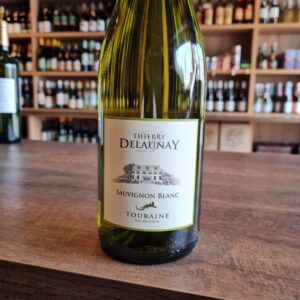 Touraine is the savvy place to look if you’re after a Sauvignon blanc which combines great value with great flavour. The Loire is Sauvignon Blanc’s homeland. So it’s no surprise that Loire native, Thierry Delaunay, is passionate about the grape. Decades of his family making wine in the region means he has the pick of the crop when it comes to choosing grapes for his wines. He looks for the best grapes from the best pockets of vines in Touraine – and the results speak for themselves. This Sauvignon is seriously refreshing, seriously citrusy, and seriously good value. You’ll find nothing finer to pair with a goat’s cheese tart. And its more restrained flavour profile makes it a perfect party wine. Santé.
Touraine is the savvy place to look if you’re after a Sauvignon blanc which combines great value with great flavour. The Loire is Sauvignon Blanc’s homeland. So it’s no surprise that Loire native, Thierry Delaunay, is passionate about the grape. Decades of his family making wine in the region means he has the pick of the crop when it comes to choosing grapes for his wines. He looks for the best grapes from the best pockets of vines in Touraine – and the results speak for themselves. This Sauvignon is seriously refreshing, seriously citrusy, and seriously good value. You’ll find nothing finer to pair with a goat’s cheese tart. And its more restrained flavour profile makes it a perfect party wine. Santé.


